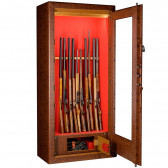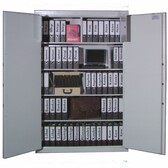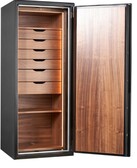Safes can be fitted with different locking methods. Before you decide to buy one, you should get an idea of which one will suit you best. Some locks are more complicated to use, while others may be less effective in some cases. Each lock has its own advantages and disadvantages. Each also has its own security class. Before you buy, check whether the lock has a security certificate that complies with European standards, as well as how to open the safe in case of failure.
How do I open a combination safe with a mechanical lock equipped with a traditional dial?
A safe with a combination lock equipped with a knob is one of the more secure safes. Unfortunately, this lock also has several disadvantages. First of all, not every person is able to open such a lock. It takes a lot of precision to unscrew the combination on the dial, so it's a rather unsuitable solution for impatient people or those who need to use the safe frequently.
A mechanical lock with a knob is also not recommended for the elderly or people with trembling hands. Imprecise movements when operating the dial will make it impossible to open the safe. The graduations and numbers on the lock are quite small, so people who wear glasses or are visually impaired may also have problems with turning the code.
Many people do not know how to open a safe with a dial, but once you become familiar with the lock, opening it becomes very easy. Most knob safes have the factory cipher: 10-20-30-40. To open the lock, you need to:
- ● Turn the dial clockwise and align the number 10 with the master graduation on the fixed dial. Then turn the knob four times clockwise and again align the number 10 with the graduation.
- ● Turn the knob anticlockwise to align the number 20 with the graduation mark and then turn the dial counterclockwise three times to align the number 20 with the graduation mark.
- ● Turn the knob clockwise again and align the number 30 exactly with the graduation. Make two full turns to the right and align the number 30 with the graduation.
- ● One last turn to the left again and set the number 40 precisely on the main scale. Finally, make one full revolution of the dial to the left and align the number 40 with the scale.
- ● After unscrewing the cipher, turn the dial all the way to the right. Then the lock opens.
How do I open a safe with an electronic lock?
In addition to a mechanical lock, safes can be equipped with electronic security features such as a numeric keypad or a fingerprint biometric lock. Some models can be opened using an app on your smartphone. Such modern locks work well when the device is used by a larger number of people.
Opening electronic safes is relatively simple. In the case of a numeric keypad, you simply punch in the code and confirm with enter. If you're using a smartphone-controlled security device, you'll need to have bluetooth wireless communication enabled – otherwise you won't connect your phone to the home safe or another safe.
Problems can arise with a biometric lock. In some cases the device may not recognise your fingerprint. How to open the safe when the biometric reader does not work? First of all, clean the device and your hand, because dirt affects the reading. The finger should not be wet and the fingerprints must be clear.
The biometric lock is not suitable for people at risk of epidermal damage. If your hands come into frequent contact with detergents that cause the fingerprints to fade, choose another security device. This lock will also be unsuitable for people whose hands often sweat.
How do I open a safe with an electronic lock if I forget the code or in the event of a breakdown?
Electronic locks need a power source to operate. Security devices equipped with a numeric keypad run on batteries, while biometric and smartphone-controlled locks require a power outlet.
In the event of a power outage or battery drain, you should know how to open the safe. Certified electronic locks have an emergency power function with a battery fed from the outside. The operating instructions describe the emergency opening procedure in case of power failure of the lock. Some electronic locks are equipped with a so-called revision, i.e. the possibility of opening with a key. In the event of a power failure or blackout, you do not have to call the service centre straight away. Please refer to the security operating instructions.
Find out: How to open a safe without a battery and what to do in case of failure?
Many locks have the revision hidden behind the front panel. You will need basic tools such as a screwdriver and a set of keys to pull the case off. Once the panel is pulled off you will see an emergency opening.
When choosing a lock, remember that you should know how to open the safe in case of an emergency. Emergency opening must not be too easy. The safe must protect the items stored in it well. Any lock is an effective safeguard as long as it has a certificate confirming its security class.
Read also: Emergency opening and service of a safe
How to change the code in a safe? Overview of the most common locks





